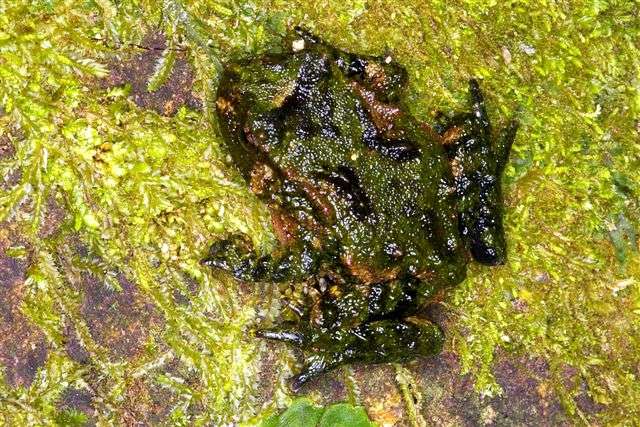Leiopelmatidae
| New Zealand primitive frogs Temporal range: 200–0 Ma | |
|---|---|
 | |
| Hochstetter's Frog (Leiopelma hochstetteri) | |
| Scientific classification | |
| Kingdom: | Animalia |
| Phylum: | Chordata |
| Class: | Amphibia |
| Order: | Anura |
| Suborder: | Archaeobatrachia |
| Family: | Leiopelmatidae Mivart, 1869 |
| Genus: | Leiopelma Fitzinger, 1861 |
| Species | |
|
See text. | |
 | |
| Distribution of Leiopelmatidae (in black) | |
The Leiopelmatidae are the family of New Zealand primitive frogs, belonging to the suborder Archaeobatrachia. The leiopelmatids' relatively primitive form indicates they have an ancient lineage.[2][3] While some taxonomists have suggested combining the North American frogs of the genus Ascaphus in the family Ascaphidae with the New Zealand frogs of the genus Leiopelma in the Leiopelmatidae family, the current consensus is that these two groups constitute two separate families.[4][5][6] The four extant species of Leiopelmatidae are only found in New Zealand.[7]
Overview
The New Zealand primitive frogs' defining characteristics are their extra vertebrae (bringing the total to nine) and the remains of the tail muscles (the tail itself is absent in adults, although it is present in the younger frogs, which need the extra skin surface until their lungs are fully developed). The family Ascaphidae (found only in North America), of the same suborder, shares these primitive characteristics, hence the two have often been described as related, or even part of the same family.
Late jump recovery is unique in Leiopelmatidae. When leiopelmatid species jump, they land in a "belly flop" fashion, repositioning their limbs for takeoff for the next jump only after hitting the ground with the ventral surface of their torsos. The appearance of early jump recovery in more advanced taxa is a key innovation in anuran evolution.[8]
They are unusually small frogs, only 5 cm (2.0 in) in length. Most species lay their eggs in moist ground, typically under rocks or vegetation. After hatching, the tadpoles nest in the male's back, all without the need for standing or flowing water. However, Hochstetter's frog lays its eggs in shallow ponds and has free-living tadpoles, although they do not swim far from the place of hatching, or even feed, before metamorphosing into adult frogs.[1] Lifespans may be long (more than 30 years) for such small organisms.[9]
Species
Family LEIOPELMATIDAE
- Genus Leiopelma
- Archey's frog, Leiopelma archeyi Turbott, 1942
- Hamilton's frog, Leiopelma hamiltoni McCulloch, 1919
- Hochstetter's frog, Leiopelma hochstetteri Fitzinger, 1861
- Maud Island frog, Leiopelma pakeka Bell, Daugherty & Hay, 1998
Extinct species
Three extinct species are known by subfossil remains, also from New Zealand. They became extinct during the past 1,000 years.[10][11][12]
- †Aurora frog, Leiopelma auroraensis
- †Markham's frog, Leiopelma markhami[13]
- †Waitomo frog, Leiopelma waitomoensis[14]
Two unnamed species are known from the earlier Miocene deposits of the Saint Bathans Fauna.[15]
See also
References
- 1 2 Zweifel, Richard G. (1998). Cogger, H.G.; Zweifel, R.G., eds. Encyclopedia of Reptiles and Amphibians. San Diego: Academic Press. p. 85. ISBN 0-12-178560-2.
- ↑ Roelants, Kim; Franky Bossuyt (February 2005). "Archaeobatrachian paraphyly and Pangaean diversification of crown-group frogs". Systematic Biology. 54 (1): 111–126. doi:10.1080/10635150590905894. PMID 15805014.
- ↑ San Mauro, Diego; Miguel Vences; Marina Alcobendas; Rafael Zardoya; Axel Meyer (May 2005). "Initial diversification of living amphibians predated the breakup of Pangaea". American Naturalist. 165 (5): 590–599. doi:10.1086/429523. JSTOR 10.1086/429523. PMID 15795855.
- ↑ Frost, Darrel R. (2015). "Leiopelmatidae Mivart, 1869". Amphibian Species of the World: an Online Reference. Version 6.0. American Museum of Natural History. Retrieved 1 September 2015.
- ↑ J.M. Conlon et al. / Peptides 30 (2009) 1069–1073
- ↑ annatella, David (2008). "Leiopelmatidae. Leiopelma". The Tree of Life Web Project. Retrieved 1 September 2015.
- ↑ "DOC: Photo-stage and Archey's Frog". Retrieved 2005-12-05.
- ↑ Essner, RL Jr; Suffian, DJ; Bishop, PJ; Reilly, SM (2010). "Landing in basal frogs: evidence of saltational patterns in the evolution of anuran locomotion.". Naturwissenschaften. 97: 935–9. doi:10.1007/s00114-010-0697-4. PMID 20625697.
- ↑ Bell, Ben D.; et al. (2004). "The fate of a population of the endemic frog Leiopelma pakeka (Anura: Leiopelmatidae) translocated to restored habitat on Maud Island, New Zealand". New Zealand Journal of Zoology. 31 (2): 123–131. doi:10.1080/03014223.2004.9518366.
- ↑ Worthy, Trevor H. (1987). "Osteology of Leiopelma (Amphibia: Leiopelmatidae) and descriptions of three new subfossil Leiopelma species". Journal of the Royal Society of New Zealand. 17 (3): 201–251. doi:10.1080/03036758.1987.10418160.
- ↑ Worthy, Trevor H. (1987). "Palaeoecological information concerning members of the frog genus Leiopelma: Leiopelmatidae in New Zealand". Journal of the Royal Society of New Zealand. 17 (4): 409–420. doi:10.1080/03036758.1987.10426482.
- ↑ Nadia Webster (2004). "Native frog captive husbandry manual" (PDF). Department of Conservation. Retrieved 29 January 2015.
- ↑ "Holotype of Leiopelma markhami". Collections Online. Museum of New Zealand Te Papa Tongarewa. Retrieved 17 July 2010.
- ↑ "Holotype of Leiopelma waitomoensis". Collections Online. Museum of New Zealand Te Papa Tongarewa. Retrieved 17 July 2010.
- ↑ Updating The Record from the Early Miocene St Bathans Fauna, Central Otago and its Significance for Documenting the Assembly of New Zealand’s Terrestrial Biota, Conference Paper · July 2014
Further reading
- D.G. Newman (1996). "Native frog (Leiopelma ssp.) recovery plan" (PDF). Department of Conservation, Wellington, New Zealand. Retrieved 2007-11-07.
External links
| Wikispecies has information related to: Leiopelmatidae |
| Wikimedia Commons has media related to Leiopelmatidae. |
- New Zealand Frog Conservation Biology - research on New Zealand frog biology